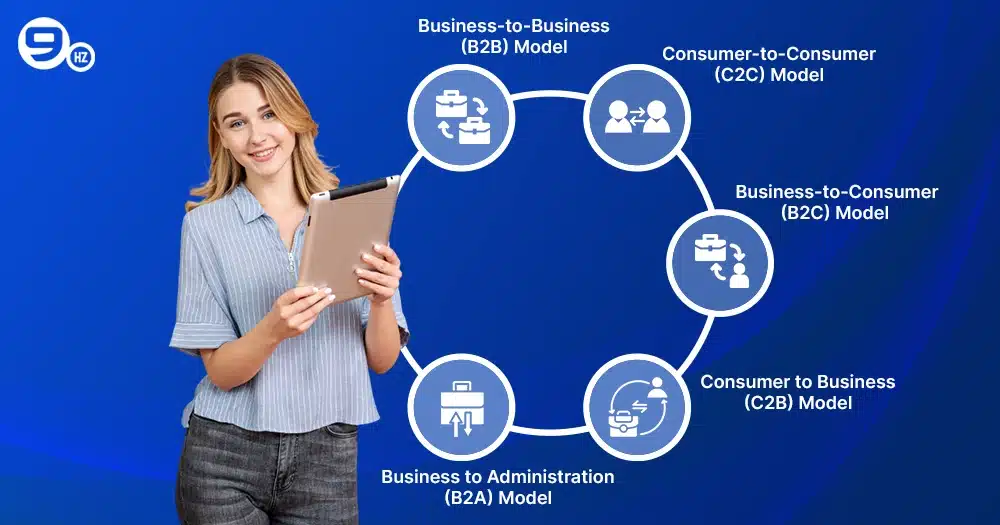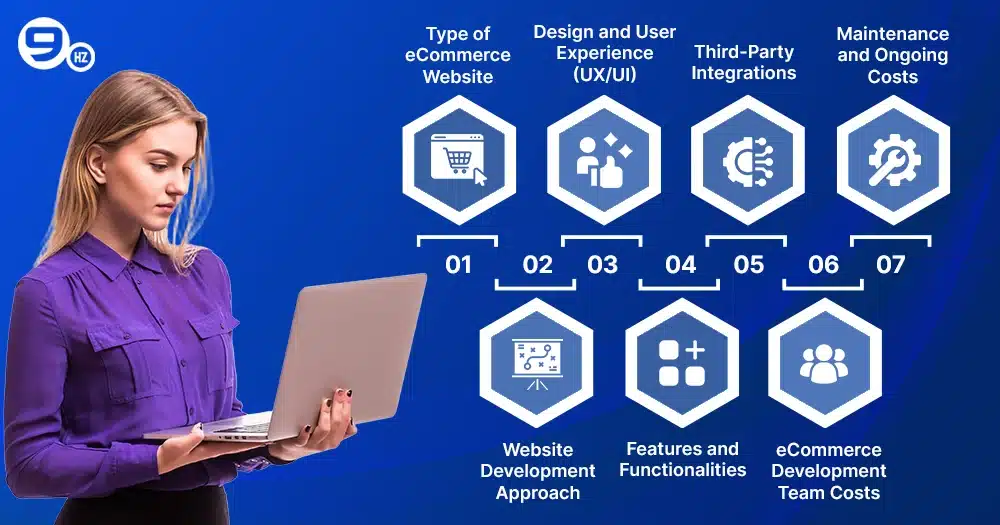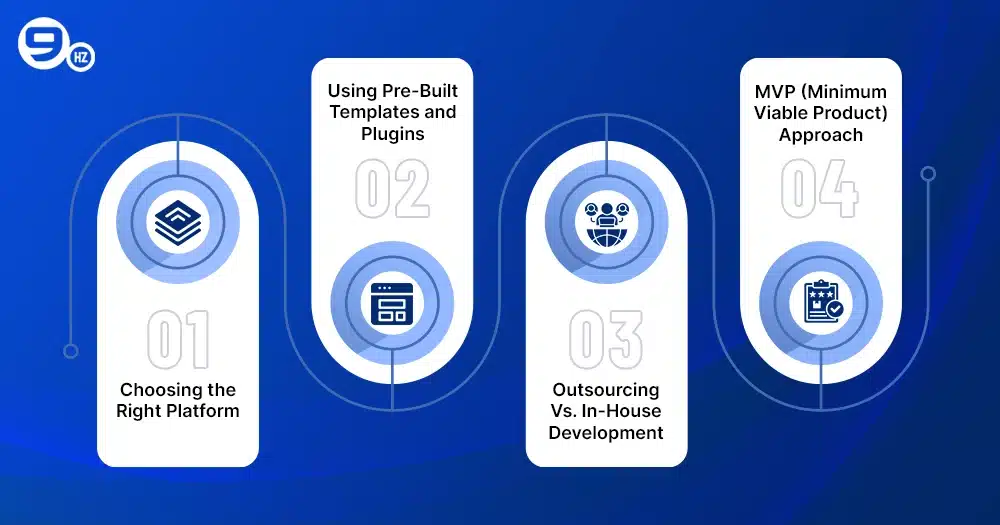Investing in building your eCommerce website should be the best decision ever. How? If not, you are missing out on the right audiences. More than half of consumers present online searching for selling goods and services. Whether it’s the model of business-to-consumer (B2C), business-to-business (B2B), or consumer-to-consumer (C2C), developers can deliver your optimized eCommerce website using the best tools and software solutions. We can cite examples of Amazon, eBay, and Alibaba, which have grown exponentially in the eCommerce space.
How does an eCommerce layout look? You can explore multiple templates to add product photos and videos, change color schemes, website themes, or product and service placements. For flawless navigation or ultimate shopping experiences, you have to keep exploring product categories, descriptions, or UI/UX designs. More than 40% of shoppers will leave your website within 3 seconds if they face issues with loading or navigation. Businesses can estimate how competitive the industry becoming!
Let’s say more than 500 customers visit your physical store at a time. Will it be feasible to handle the rush? Building an eCommerce website can handle huge traffic, delivering the best user experience. If we look into growth, it is estimated that the global market for B2C eCommerce is projected to grow with a revenue of $5.5 trillion by 2027. So, how to develop a website? is it that easy to use a drag-and-drop solution for an eCommerce site? Pre-build templates work great for a basic website, but if you are looking for advanced features, hire eCommerce website development company. Their team will guide you on eCommerce website development costs, product tech stacks, ease of navigation, SEO implications, and secure the web with SSL certifications.
What is eCommerce Website Development?
An eCommerce website development refers to the process of building an online store that helps businesses sell products and services. It involves a series of steps, including website design, product catalogs and descriptions, a shopping cart, payment gateway integration, SEO and mobile responsiveness, security, and customer services.
Although third-party eCommerce platforms exist to promote sales like Amazon or eBay Sellers, brands still prefer their customized eCommerce store to grow their brand image. Recently, the advent of online marketing has transformed the buyer persona into one that prefers more convenient shopping, product selection, or easy price comparison.
Let’s list down the steps for eCommerce website development:
- Defining your online brand by showcasing products or services.
- Set a business goal and build a eCommerce website on user preferences.
- Pick the right eCommerce platform that suits usability, SEO, pricing, or feature integration.
- Categorization of products by adding descriptions.
- Planning for content strategy on what value to add to the website.
- Integrate features for placing orders, adding to cart, and filters.
- Adding secured payment gateways.
- Deploy the website and perform functional testing.
Different Types of eCommerce Websites
Like any other web development, there is no one-size-fits-all layout, and online business comes with diverse expectations. So, as the trends roll out for the marketplace, every business, whether it is a fashion store, retail store, appliance store, grocery store, or even bakery shop, follows a specific pattern of eCommerce templates. Here are different types of eCommerce websites:
Business-to-Business (B2B) Model
It denotes the eCommerce model, where a business sells products and services to another company. This can connect manufacturers with wholesalers or between wholesalers and retailers through online platforms. With less infrastructure setup and overhead costs, it can offer the best growth opportunities and eliminate intermediaries.
Examples: Amazon Business, Moglix, IndiaMart, Udaan, or Flipkart Wholesale
Consumer-to-Consumer (C2C) Model
This model takes eCommerce to the next level by creating a marketplace where customers can connect to complete transactions and sell any product or service. It starts with the idea of selling unused items and arts and crafts to grow personal brands.
Examples: eBay, Craigslist, Airbnb, Facebook Marketplace, or Etsy
Business-to-Consumer (B2C) Model
It represents the transactions between consumers and businesses focused on selling directly to end customers. This eCommerce website offers the best user experiences, personalized recommendations, and checkout options, following the digital marketing strategies of email marketing and social media advertising to drive more traffic.
Examples: Amazon, Walmart, Apple, Nike or ZARA
Consumer to Business (C2B) Model
It represents a reverse sequence of traditional eCommerce where the consumers sell products or services to the business. Consumers can create value by offering ideal products and developing content like writing reviews for a company’s website blog or services that provide cost advantage for businesses.
Examples: Fiverr, Upwork, Amazon Influencers Program, Amazon Associates, or Rakuten Marketing
Business to Administration (B2A) Model
This B2A model represents companies that make business transactions with government agencies. Here, software providers sell a specific service to government institutions that offer high order value or long-term sales cycles. It can easily operate with a small number of customers and limited government contracts in hand.
Examples: Services can be IT solutions, defense and security, healthcare, Education, or consulting
Depending on different goals and target audiences, here are some delivery frameworks to define the success of eCommerce business:
- Dropshipping
- Subscriptions DTC
- Private label or White label
- Direct to Customer
- Wholesale
eCommerce Website Development Cost Breakdown
Running a physical retail store can be expensive, but what are the costs of developing an e-commerce website? eCommerce development company consider multiple factors, such as domain registrations, e-commerce website prices, payment gateway fees, maintenance costs, marketing costs, Shopify payments, and ongoing maintenance.
Here is the table to define each step and help you understand the eCommerce website development cost breakdown:
| Step | Component | Estimated Cost (USD) | Description |
|---|---|---|---|
| Step 1: Planning & Research | Market Research & Competitor Analysis | $500 – $2,000 | Research on industry trends, competitors, and customer needs. |
| Business Model Development | $500 – $3,000 | Planning the revenue model, logistics, and payment strategy. | |
| Step 2: Domain & Hosting | Domain Name Registration | $10 – $50 per year | Cost of acquiring a domain like .com, .shop, etc. |
| Web Hosting (Shared/VPS/Dedicated/Cloud) | $100 – $1,000 per year | Hosting server cost is based on site size and traffic. | |
| Step 3: Website Design & UI/UX | Wireframing & Prototyping | $1,000 – $5,000 | Designing website structure and user journey. |
| UI/UX Design | $2,000 – $10,000 | Creating visually appealing and user-friendly designs. | |
| Responsive Design (Mobile Optimization) | $1,000 – $5,000 | Ensuring the mobile device compatibility. | |
| Step4: Website Development | Frontend Development (HTML, CSS, JavaScript) | $5,000 – $15,000 | Developing the user interface. |
| Backend Development (PHP, Node.js, Python) | $10,000 – $30,000 | Server-side development, database integration, and logic. | |
| Content Management System (CMS) Integration | $2,000 – $10,000 | Using WordPress, Shopify, Magento, or custom-built CMS. | |
| Step 5: E-commerce Features & Functionality | Shopping Cart & Checkout System | $2,000 – $10,000 | Developing cart, checkout, and order processing. |
| Payment Gateway Integration (Stripe, PayPal) | $500 – $5,000 | Secure payment processing setup. | |
| Product & Inventory Management | $2,000 – $10,000 | Adding product listings, stock management. | |
| User Account & Authentication System | $1,500 – $8,000 | Allowing user registration and login. | |
| Order Tracking & Notifications | $1,000 – $5,000 | Enabling real-time order updates. | |
| Multi-Vendor Marketplace Feature | $5,000 – $25,000 | Adding multiple seller support (like Amazon, Etsy). | |
| Step 6: Security & Compliance | SSL Certificate & Security Setup | $100 – $1,000 | Ensuring secure HTTPS encryption. |
| Data Privacy & GDPR Compliance | $500 – $5,000 | Implementing legal policies for user data protection. | |
| Anti-Fraud & Secure Payment System | $1,000 – $5,000 | Fraud detection and security protocols. | |
| Step 7: Content Creation & SEO | Copywriting & Product Descriptions | $500 – $5,000 | Creating engaging product details and web copy. |
| SEO Optimization & Keyword Research | $1,000 – $7,000 | Improving website visibility on search engines. | |
| Blog & Content Marketing | $1,000 – $10,000 | Writing articles to drive organic traffic. | |
| Step 8: Marketing & Branding | Logo & Brand Identity | $500 – $5,000 | Creating a unique brand design. |
| Social Media Integration | $500 – $3,000 | Connecting social media profiles for promotions. | |
| Email Marketing & CRM Integration | $1,000 – $8,000 | Setting up email campaigns, and newsletters. | |
| Step 9: Testing & Quality Assurance (QA) | Website Testing (Functionality & UX) | $1,000 – $7,000 | Ensuring seamless performance and usability. |
| Performance & Speed Optimization | $1,000 – $5,000 | Reducing loading time and improving performance. | |
| Step 10: Deployment & Launch | Server Setup & Deployment | $500 – $3,000 | Moving the website to a live server. |
| Beta Testing & Final Adjustments | $1,000 – $5,000 | Fixing last-minute bugs and performance checks. | |
| Official Website Launch | $500 – $3,000 | Making the eCommerce website live. | |
| Step 11: Maintenance & Support | Technical Support & Bug Fixes | $1,000 – $10,000/year | Ongoing support for perfect operation. |
| Regular Updates & New Features | $2,000 – $15,000/year | Adding new functionalities and security updates. |
Depending on your store size, capacity, and product categories, check out this table representing development cost estimations:
| Website Size | Features & Complexity | Estimated Cost Range | Development Timeframe |
| Small Store |
|
$2,000 – $10,000 | 1 – 3 months |
| Medium Store |
|
$10,000 – $30,000 | 2 – 6 months |
| Large Store |
|
$30,000 – $100,000 | 4 – 12 months |
| Enterprise |
|
$100,000+ | 6 – 18 months |
How to Calculate Cost of Developing an eCommerce Website?
Depending on the eCommerce platform, features, web design, complexities, or development team. Here are the following steps to follow for calculating eCommerce development costs:
- Step 1: The foremost step in calculating development costs is to define your business, whether in terms of several product categories, customized features, or a technology stack, including frameworks, languages, web servers, payment gateways, or cloud hosting.
- Step 2: The next factor is designing costs that depend on the website’s complexities for elements, like logo, layout, and banners. You have the option to hire a web designer or depend on agencies to grow your brands online.
- Step 3: Calculate overall development costs by managing frontend or backend by selecting the right platform, content management systems, domain, hosting, SSL certificate, shipping, and website maintenance or support.
- Step 4: You can integrate additional features of promoting tools, email marketing, social media integration, abandoned cart, or website analytics and reporting.
- Step 5: Estimating marketing costs is crucial to driving more sales and traffic. It comprises expenses for SEO, digital marketing, influencer collaborations, and Social media campaigns.
- Step 6: Also, consider factors such as maintaining websites with regular updates, server costs, security checks, or other essential costs.
Design Cost = Number of Designs * Hourly Rate
Need Help with eCommerce Website development?
Hire Certified eCommerce Developers
Factors Affecting the Cost of Developing an eCommerce Website
Managing a fully optimized eCommerce website is not that easy! From researching for ideal products or services, trying multiple templates, user registration, and several other factors affecting estimated eCommerce website development costs, Let’s discuss suggesting a few factors:
Type of eCommerce Website
It is essential to understand which type of eCommerce website your client prefers based on the B2B or B2C model and industry-specific, whether it is a simple layout with coding or a complex one to customize websites considering usability and performance.
Website Development Approach
Multiple eCommerce development approaches exist depending on several factors, including business needs, budget, and complexities. These can include DIY website development, open-source platforms, SaaS-based solutions, or custom development using Python, .NET, or React.
Design and User Experience (UX/UI)
Website design acts as a user interface that creates a first impression with easy navigation, visual elements, and elements of custom graphics, branding, or engagements. So, if you opt for minimal elements, there will be fewer cost implications, while the advanced version will create more development costs.
Features and Functionalities
eCommerce websites have listed features such as product pages, shopping carts, secured checkout processes, search functionalities, and mobile responsiveness. As you can add more advanced features, your website development cost will increase.
Third-Party Integrations
As the marketplace is competitive, fashion, retail, and automobile brands are pushing advanced product displays using Zoom-in, 360-degree views, or related products. To increase usability, you can integrate social media tools, content management, or customer support services for live chat, help centers, or contact forms.
eCommerce Development Team Costs
The developing team comprises a project manager, front-end or back-end developers, full-stack developers, UI/UX designers, and QA testers. Depending on your project size and scope, they will be charged on an hourly or project basis.
Maintenance and Ongoing Costs
When budgeting for eCommerce websites, it is crucial to consider maintenance costs, which include hosting, server maintenance, software updates, customization, security tools, and data privacy compliance.
How to Reduce eCommerce Website Development Costs?
Are you struggling to develop an online store but stuck with budget issues? Depending on the size and type of your business, functionalities, or features, you can minimize website development costs. Here are a few suggestive ways to try on:
Choosing the Right Platform
You can choose between picking the right platform, such as hosted platforms like Shopify, Wix, or BigCommerce. Hosted platforms provide lower initial costs, a maintenance-free website, and scalable solutions. An open-source platform or website builder like OpenCart, WooCommerce, or Magento will also lessen overall development costs.
Using Pre-Built Templates and Plugins
Additionally, you can save on development costs by opting for pre-built themes, plugins, and templates for custom design. These can even start at $50 and are easily accessible on platforms like the Shopify Store. Otherwise, building from scratch can significantly increase the overall cost.
Outsourcing Vs. In-House Development
Hiring a team of developers with specialists, skilled experts, or professional web designers will increase the cost burden and expand your budget. However, if you prefer to outsource, it will reduce the budget to a certain level through flexible working.
MVP (Minimum Viable Product) Approach
By referring to the minimum viable product for an eCommerce store it refers to no-code or low-code platforms, including Bubble, Shopify, Wix eCommerce, or Squarespace. It helps you to build your eCommerce store with basic features and fits well with your budget.
How The NineHertz Can Help You With eCommerce Website Development?
If you are searching for the right eCommerce website development company, The NineHertz is your reliable partner. The tech team does not just handle your eCommerce store setup but also assists with a chatbot, AI-powered inventory tracking, logistics solutions, warehouse management, or eCommerce POS. As the industry grows, investing in an eCommerce website can help brands with personalized marketing, fast shipping, data-driven sales, and brand visibility to mark unique places in the digital marketplace.
The NineHertz has accomplished the milestone of delivering more than 1300 projects with 200+ industry experts. The innovative team can use the technology stack of AngularJS, ReactJS, Vue.js, JavaScript, HTML 5, and CSS3 to develop your custom eCommerce website without any delays. It can offer you the advantages of zero-cost evaluation, timely delivery, an experienced team, affordable prices, tailored approach, code ownership, or data security.
Conclusion
By the end of the blog, we can say that investing in your eCommerce website can be the smartest decision ever! Search for the right software development company; they can help you with cost-saving strategies, communication, customization, and third-party integration. Also, as consumers are shifting towards mobile shopping, businesses like electronics, furniture, or fashion prefer eCommerce development to find the right target audience for customization and scalability. You can explore hosted eCommerce platforms with paid themes or customer features to venture for your successful eCommerce business!
FAQ’s
1. How Long Does it Take to Develop an eCommerce Website?
It will depend on website size or features integrations. The basic version will take around 2 to 4 weeks, while the advanced version can fall within a range of 3 to 6 months.
2. What are the Hidden Costs of eCommerce Website Development?
Some of the hidden costs are hosting, payment processing, plugins, security, website maintenance or updates, third-party APIs, marketing ads, returns, and customer support.
3. How Much does it Cost to Develop a Website like Amazon?
It can range between $30,000 to $5,00,000 to develop an eCommerce website like Amazon, depending on features, custom solutions, or development team locations.
4. How to Depreciate eCommerce Website Development Costs?
By depreciating, you allocate expenses over multiple years to generate taxable income. This can be achieved by following the right depreciation method, accounting for website maintenance, determining the depreciation period, and considering tax implications.
Great Together!












